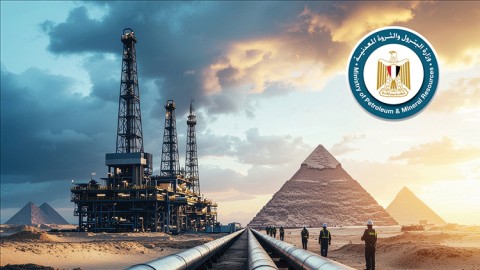By Nadine Abou el Atta
Often the solution to one problem is through solving another. Since its commercialization, Egypt’s energy mix has been largely skewed towards natural gas; a factor that created an energy crisis at one point.
Throughout the past few years, the state had invested billions to close the demand-supply gap, reaching an all time high of $3.55 billion in 2015/2016 alone, an official at EGPC told Reuters. The crisis initially grew in response to the government’s decision to favor meeting local electricity demands, over securing feedstock to factories. Despite passing the peak of the crisis, Egypt’s foreign reserves, the profitability of some factories, and the financial burden piling up on public entities are still yet to recover.
At the peak of the crisis, the Egyptian state made the decision to liberalize the natural gas market. The Egyptian Natural Gas Holding Company (EGAS) alongside the Egyptian General Petroleum Corporation (EGPC) announced in the month of May 2015 the decision to allow private companies to use the state-owned national gas grid to import, transfer, and distribute natural gas to the local market.
A Breakdown of the Law
After years of deliberation, the gas regulation law was finally issued July 2017. Law 196 for 2017, includes 53 articles divided into five sections. The provisions of the legislation shall be applied to regulate the activities of the natural gas market in Egypt with the exception of petroleum concession agreements, which follows the law number 20 for 1976.
The petroleum and mineral resources minister is to issue within six months the executive regulations of the draft law; where companies operating in the natural gas market will be provided a transactional grace period to adjust their conditions.
The decree’s first section includes definitions of the main terminologies mentioned in the law and their field of application. The second section of the law refers to the establishment of an independent regulatory body, named Gas Market Regulatory Authority; the purpose of which is to regulate, follow up and control all activities related to the natural gas market in Egypt. Furthermore, the authority will be responsible for ensuring the availability of gas, the availability of a well functioning natural gas grid and related facilities. Additionally, the law states that the authority is responsible for ensuring that the market remains free of any monopolistic practices.
Breaking down further the practices of the authority, the second section of the law highlights that the regulatory body will be responsible for all planning and execution related to granting and renewing operation licenses; establish regulations for the use of the national gas grid, facilitate the transportation process of natural gas, and establish mechanisms for the calculation of tariffs.
The authority, according to the legislation, will be responsible for setting the control mechanism for the importing, re-gasification, transportation, distribution, and storage of the natural gas. The independent body is expected to insure that the market remains transparent and reaches a free competitive state.
The same section also highlights that the authority will be responsible for setting its own financial resources and revenue streams; in addition to determining the members of its board and the length of their tenure.
The third section of the law breaks down the rules governing the different activities of the gas market and the obligations on different parties. Furthermore, it highlights the obligations and rights of all members operating in the natural gas market, from operational entities down to the final consumer; in addition to a clear a breakdown of the different operational stages and possible parties included.
The fourth section, revolved around penalties in case of any violations of the provisions of the law, in addition to granting the status of judicial control officers to the employees of the authority, which shall be determined by a decision of the Minister of Justice. Finally, the fifth section includes transactional regulations.
The Ignite
Since its announcement local media has been buzzing at both ends of the spectrum; at one end, speculators deem the move as mundane, while on the other are announcements of a new revolutionary era.
In order to remove the media factor and stick to the economic foundation of the move, Egypt Oil & Gas sat down with, Economist Mohamed Khafagy, General Manager for Natural Gas and Economic Affairs in EGAS. Khafagy headed the core team involved in the calculation of the charged tariffs by the regulatory body, as well as the establishment of different operational mechanisms.
Khafagy began his interview by explaining the need for the regulatory body. “The regulator essentially was launched to ‘regulate’ the gas market. There was no entity regulating the market, monitoring companies that enter or exit the gas market, nor how different entities deal with each other.”
Until the approval of the law, EGAS had the sole role in the market to sell natural gas, and distribute through its subsidiaries, which include GASCO, Khafagy explained. “As a result EGAS endured significant financial burdens; the company needed to meet the increasing demand of all sectors, a fact that created many issues. Thus, the state, believed that different companies should be allowed to sell natural gas in the local market, the market needed to open up,” he added.
Process
To understand the exact process involved, Egypt Oil & Gas began by asking about the different entities eligible to apply, for which Khafagy explained that any operating company has the right to apply for a license to import and distribute natural gas, including industrial end consumers. “According to the law a factory has the right to import directly without buying from an intermediate; however, no factory has shown interest to take this step to date,” he affirmed. On the receiving end, entities eligible under the law to choose their own supplier of natural gas are both the industrial sector and private power plants that follow the BOOT system.
According to media sources, three companies gained initial approval, while four are in the application process. When asked Khafagy highlighted that the “companies that took preliminary approval include TAQA, Roseneft, and Fleet Energy […] and one of the companies that is in the process of achieving initial approval is Toyota.”
To receive approval to import and sell natural gas in the Egyptian market, companies need to submit documentation proving purchase of natural gas from a supplier; proof of composition of the natural gas imported; a contract with a local buyer; financial documentation proving the strong standing of the importing company for the previous three years, Khafagy commented adding that if everything proves well, the company is given initial approval for six months during which it has to obtain final approval or begin the process from scratch again.
Once initial approval is provided, GASCO needs to confirm that capacity exits in distribution lines. Subsequently, EGAS provides confirmation that there is enough capacity in one of the FRSUs to accommodate the imported gas, he continued.
When asked about the general availability of capacity in FSRUs, Khafagy explained that “on paper there is an average of 50% to 60% available combined capacity for at least the coming four years. This percentage is expected to increase as local production is on the rise and government imports are declining, especially starting 2019.”
Tariff Calculation
According to Khafagy, there are two types of tariffs: Transportation tariff and distribution tariff. The former was calculated based on all encountered costs, whether overheads, infrastructure, or operational costs. “Currently to transport natural gas it costs the state 38 cents per mBtu.”
However, this is only the tariff imposed for transportation. Private entities will still be subject to a distribution tariff, which is yet to be determined, as there are currently 16 companies in Egypt handling the distribution of natural gas, each of which has its own infrastructure, size, investments, and operational costs; thus, setting a standard distribution tariff is demanding additional time.
EGAS vs. Market
Moving on, the discussion began to address the coming role of EGAS both in terms of existing commitments and in terms of conflict of interest. Beginning with the latter, especially given that EGAS, one of the players in the market, will also be the regulating entity, many would view the arrangement as conflicting, for which Khafagy affirmed that “the gas regulator will be a separate entity from EGAS. They will both report to the ministry, yet they will remain completely financially independent.” EGAS will be treated as a regular market player; it will obtain a license like other private members.” However, what is currently under discussion is whether EGAS as a whole will become a market player or whether a separate company will be launched to deal with the gas regulatory authority as a market distributor, he explained.
Addressing the initial point about the state’s commitments, Khafagy remarked that “EGAS will begin to remove part of its commitments with factories as the market begins to liberalize, for example we were committed to supplying fertilizer factories with 100% of their feedstock needs, currently we supply around 80%. Once companies will begin importing natural gas, EGAS will confirm its commitment to only 70 – 80% and the factory will be obliged to import the remainder of its needs. Essentially we will have a liberalized market of buyers and sellers, not one company handling everything.”
When asked if EGAS had plans to revoke all its supply commitments with factories in the near future, Khafagy was adamant on the issue stating that this is not an option. “We give power plants subsidized natural gas, which increases our financial burden, thus, EGAS’ supply to factories is what helps the company breakeven. Factories should not worry about revoking our commitment to supply them with feedstock.”
Breaking down the calculation, Khafagy explained that “as of now, Egypt still imports about a third of its natural gas needs. What this means is that our cost to supply the market is the combination of the production of two thirds of Egypt’s natural gas plus the cost of importing the remaining third. This makes the average cost of natural gas for EGAS to be around $4.5 per million British thermal unit (mBtu). We then sell to power plants at a standard cost of $3 per mBtu, the difference is met through supplying feedstock to the industrial sector.”
Quality of Service is a Factor
One question speculators may have is how can a private importer insure that the government will not simply use the natural gas to feed its power plants? For which Khafagy answered, “we have imposed several measures to secure the rights of all entities. In this case GASCO, which will be handling distribution arrangements though its infrastructure, will guarantee that the quantity it receives reaches the final buyer. If that did not happen, GASCO will be subject to extensive financial penalties, which will amount to more than what the final buyer was contracted to pay. Furthermore, what is comforting to market players is that Egypt’s gas production is on the rise, we will soon have excess, thus removing any lingering threat that the state would revert to the supply of the private sector.”
Addressing questions on the difference in prices between natural gas supplied by EGAS and that imported by private companies, Khafagy clarified that as the government begins to remove subsidies things should become more competitive in orientation, he highlighted that “the quality of services will also be a factor in this equation. A company can offer to meet 100% of a factory’s needs and show outstanding commitment and a stabilized price offering, essentially all companies will reach a point where they compete with a complete package of offerings […] The high operational costs for EGAS is also a factor influencing our cost and prices, it may end up being easier for private companies to reduce their prices.”
It is, however, important to note that the market will not be 100% competitive in a couple of years, he added; “looking at other markets who adopted this direction we will find that any regulator takes time to be well established, UK’s gas regulator, for example, took 11 years to be fully functional. We still have a long way to go.”
In terms of charges applied, Khafagy confirmed that the gas regulator will have a clear explanation of the methodology used to calculate tariffs on its website; in order to help assure the private sector that charges are not arbitrary but reflect the exact cost of transportation and distribution of natural gas. He went on to add that the Agence Francaise de Developpement (AFD) has agreed to give Egypt a grant for the evaluation of its natural gas grid and related assets, “this will help highlight why we charge these specific amounts,” he explained.
Impact Subsidies and National Budget
It is believed that the move will improve the national budget before it improves foreign currency reserves. When asked about the topic, Khafagy commented, “this shift will allow the state to pay its dues. Currently our costs are too high to secure revenue to the state, once the market is liberalized, and subsidies are removed, the government will reach a point where there is a sufficient gap between cost and revenue.”
Concluding the interview, Khafagy said: “It is a circle once it begins to improve, it will affect all aspects of the economy. As our import and subsidies burden eases, we will be able to pay our dues to foreign investors, enhancing the perception of the market’s profitability, and thus attracting more investments into the country. The same thing happens when something falls, other aspects in the circle will begin to fall as well.”
As Egypt took a bold first step, it is far too early to forecast a direction, the state has a long way to go in terms of ensuring that well laid plans will result in outstanding economic performance. Yet, initial signs and comparisons with advanced markets that took these steps all paint a bright picture for Egypt’s liberalized gas market.








